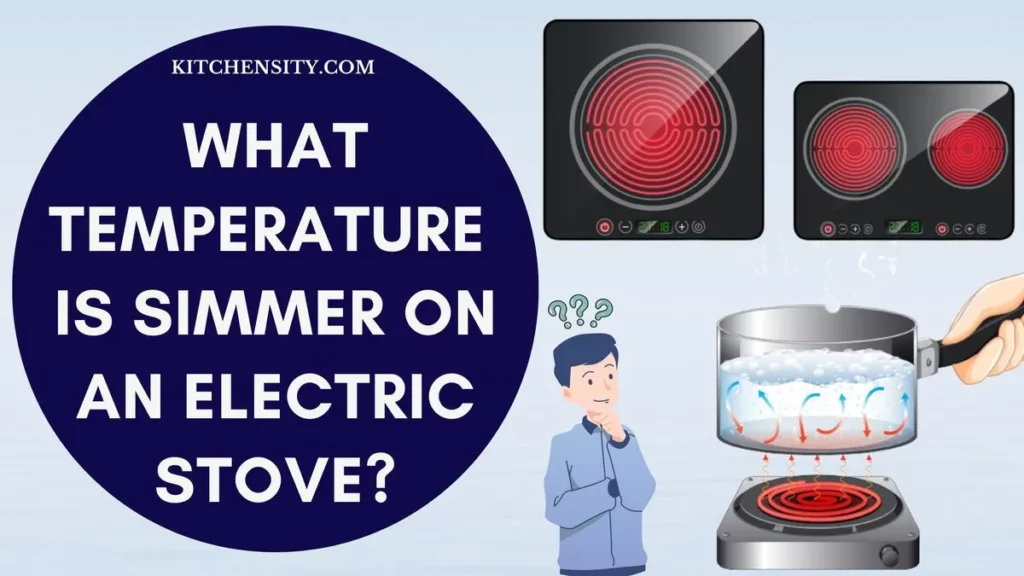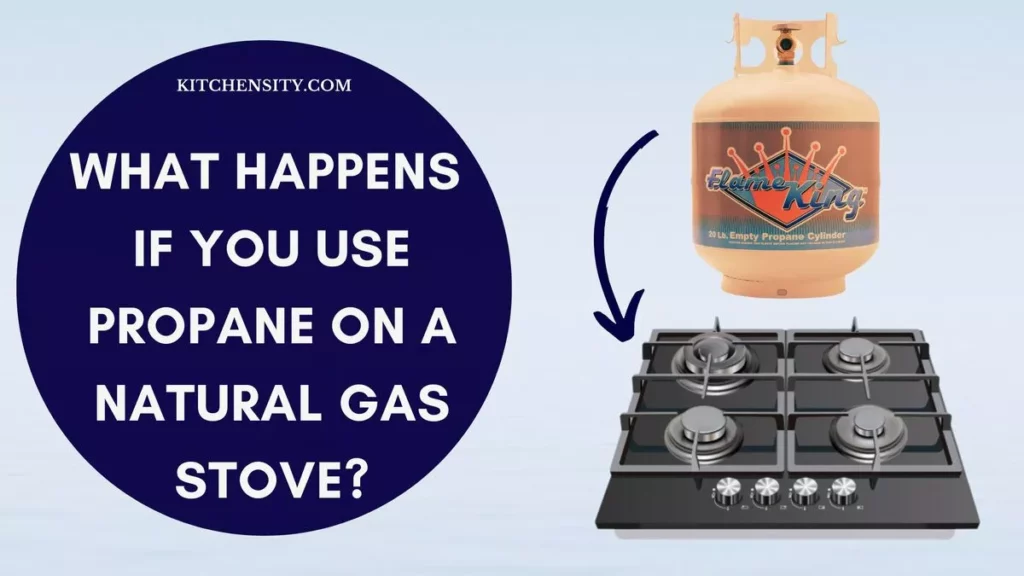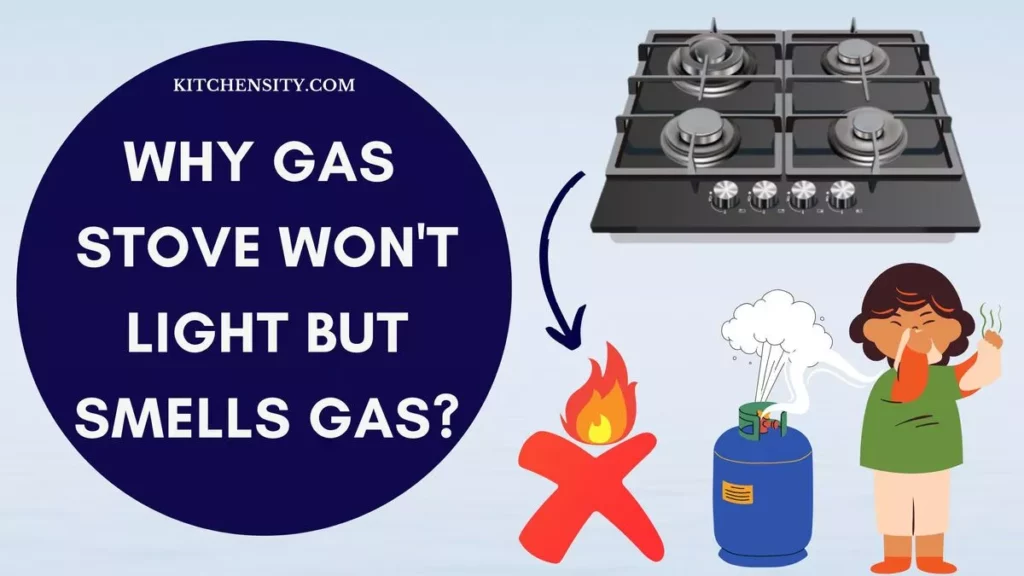Gas stoves have been a staple in kitchens around the world for decades, providing efficient and precise control over cooking temperatures.
When your gas stove is functioning properly, the flames should burn with a crisp, blue appearance.
However, many people have encountered a perplexing issue – an orange flame on their gas stove.
In this article, we’ll unravel the mystery behind this phenomenon, and discuss the potential causes, safety concerns, and how to remedy the situation.
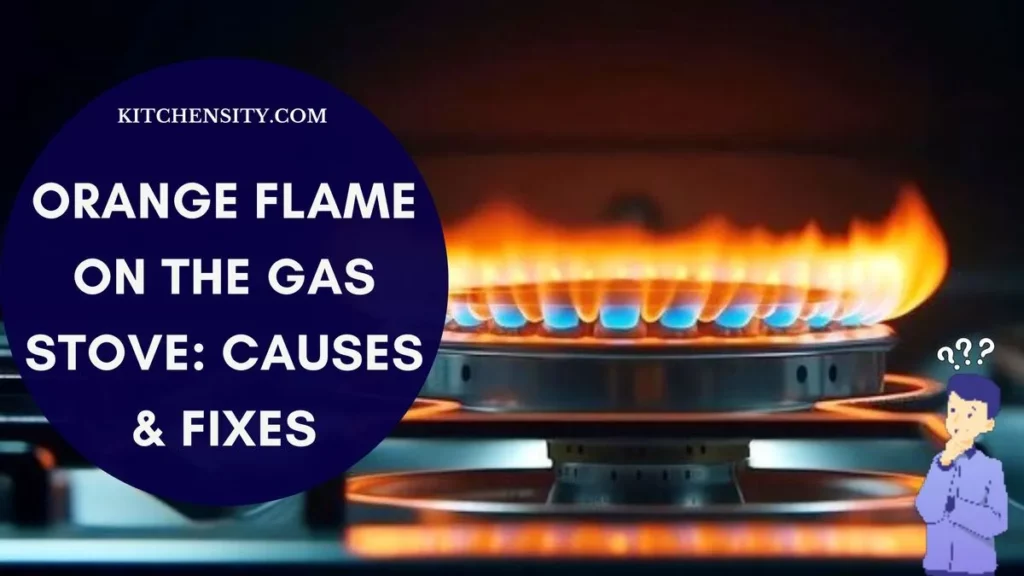
Table of Contents
- 1 What Causes An Orange Flame On The Gas Stove?
- 2 Is Orange Flame On A Gas Stove Dangerous?
- 3 How To Fix The Orange Flame On The Gas Stove?
- 4 What Is The Importance Of A Blue Flame?
- 5 Can Humidity Cause Orange Flames On The Gas Stove?
- 6 Does Orange Flame Mean Too Much Gas?
- 7 Does Orange Flame Always Mean Carbon Monoxide?
- 8 How To Prevent Orange Flame On The Gas Stove?
- 9 When To Seek Professional Help?
- 10 Final Verdict
- 11 FAQs About Orange Flame On The Gas Stove
- 11.1 Why Are The Flames On My Stove Turning Orange?
- 11.2 Is It Safe To Use A Stove If The Flame Is Orange?
- 11.3 Is It Safe To Use A Gas Stove With An Orange Flame?
- 11.4 Can I Fix The Orange Flame Issue Myself?
- 11.5 What Is The Ideal Air-To-Fuel Ratio For A Gas Stove?
- 11.6 How Often Should I Clean My Gas Stove Burners?
- 11.7 Is There A Way To Prevent Orange Flames From Occurring In The First Place?
What Causes An Orange Flame On The Gas Stove?
An orange flame on a gas stove is primarily caused by incomplete combustion. This incomplete combustion occurs when the air-to-fuel ratio is imbalanced, often due to factors like dirt or debris on the burners, incorrect adjustments, or inadequate ventilation.
As a result, the gas doesn’t burn efficiently, leading to the orange or yellow appearance of the flame. These factors mainly contribute to this phenomenon:
- Dust And Dirt Buildup: Over time, gas burners can accumulate dust, dirt, and food residue. This accumulation can disrupt the flow of gas and interfere with the proper air-to-fuel ratio, leading to incomplete combustion and the appearance of an orange flame.
- Incorrect Air-To-Fuel Ratio: The combustion process in a gas stove requires a precise balance of air and fuel. If the air-to-fuel ratio is not balanced correctly, it can result in an orange flame. This imbalance can be caused by issues with the stove’s regulator or improper adjustments.
- Ventilation Problems: Proper ventilation is crucial for gas stoves. If there isn’t enough airflow to the burners, oxygen levels can be insufficient for complete combustion. Inadequate ventilation can lead to an orange flame.
It’s important to note that an orange flame is not just an aesthetic issue; it can also pose safety concerns. Incomplete combustion produces carbon monoxide, a potentially deadly gas.
Additionally, an orange flame can increase the risk of fires and gas leaks, as unburned gas may escape and ignite unexpectedly. Therefore, it’s essential to address the causes of an orange flame promptly to ensure the safety and efficiency of your gas stove.
Also Read – How To Fix A Yellow Flame On A Gas Stove?
Is Orange Flame On A Gas Stove Dangerous?
Yes, an orange flame on a gas stove is dangerous. It is a sign of incomplete combustion, which can produce carbon monoxide, a poisonous gas, and can have several safety implications:
- Carbon Monoxide (CO) Risk:
- Incomplete combustion produces carbon monoxide (CO), a colorless, odorless, and toxic gas.
- When you see an orange flame, it means that not all the gas is burning properly, leading to higher levels of CO in the air.
- Breathing in carbon monoxide can be harmful and even life-threatening in high concentrations.
- Fire Hazards:
- An orange flame can also increase the risk of fires and gas leaks.
- When the gas does not burn completely, unburned gas may escape from the burner and accumulate in the surrounding area.
- This can create a potential fire hazard, as any spark or ignition source can ignite the accumulated gas.
- Appliance Damage:
- Incomplete combustion can also harm your gas stove over time.
- The soot and residue produced by an orange flame can build up on the burners and other components, potentially leading to the deterioration of the stove and the need for costly repairs.
For these reasons, it’s crucial to address an orange flame on a gas stove promptly. If you notice an orange flame, it’s best to stop using the stove, ventilate the area, and seek professional assistance to diagnose and resolve the issue.
Regular maintenance and proper stove usage are essential to prevent the occurrence of orange flames and ensure your safety while cooking.
Also Read – Do Gas Stoves Turn Off Automatically?
How To Fix The Orange Flame On The Gas Stove?
Fixing an orange flame on a gas stove is essential to ensure safety and efficiency. This issue typically indicates incomplete combustion, which can be caused by various factors. Here’s a step-by-step guide on how to address and fix the orange flame problem:
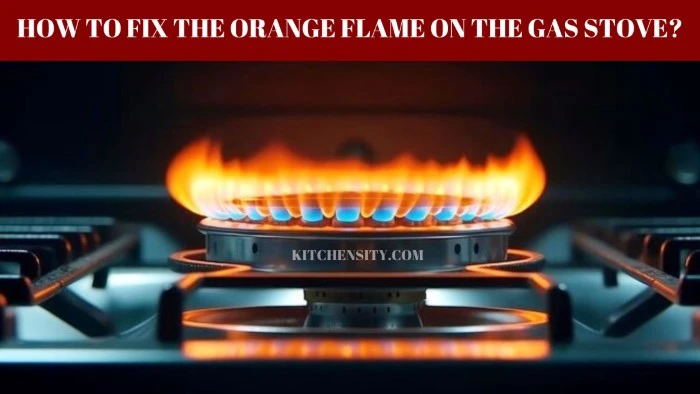
Please note: Before attempting any repairs, ensure your safety by turning off the gas supply to the stove and allowing it to cool down if it has been in use.
- Gather The Necessary Tools:
- Screwdriver
- Wrench (if required for your specific stove)
- A soft brush or cleaning cloth
- Compressed air can (optional)
- Safety goggles and gloves (for safety)
- Cleaning The Burners:
- Remove the grates and burner caps from the stove. This will give you access to the burners.
- Using a soft brush or cleaning cloth, clean the burners thoroughly to remove any accumulated dirt, debris, or food residue. Pay special attention to the burner ports.
- If the burners are particularly dirty, you can use compressed air to blow away stubborn debris.
- Ensure that the burners are completely dry before reassembling them.
- Adjusting The Air-To-Fuel Ratio:
- Refer to your stove’s manual for specific instructions on adjusting the air-to-fuel ratio. Different stoves may have different mechanisms for achieving the proper balance.
- Common methods for adjusting the air-to-fuel ratio include:
- Adjusting The Air Shutter: This is usually a small metal plate located near the burner. You can use a screwdriver to open or close it slightly to regulate airflow.
- Checking The Regulator: Some stoves have a regulator that controls the gas flow. Ensure it is functioning correctly and consult the manual for adjustment instructions.
- Checking For Ventilation Problems:
- Ensure that your kitchen is well-ventilated. Open windows or use an exhaust fan to improve airflow. Sufficient oxygen supply is crucial for proper combustion.
- Make sure there are no obstructions around the stove that might impede the flow of fresh air.
- Reassemble And Test:
- Once you have cleaned the burners and adjusted the air-to-fuel ratio, reassemble the stove components, including the grates and burner caps.
- Turn on the gas supply and relight the burners.
- Observe the flames. They should now appear blue and stable, indicating proper combustion.
- Monitor Over Time:
- Keep an eye on the flames during regular stove usage.
- If you notice the flames turning orange again or encounter any other issues, it’s essential to address them promptly.
If, after following these steps, you are still experiencing orange flames on your gas stove, or if you feel uncomfortable making adjustments yourself, it’s recommended to contact a qualified technician or appliance repair professional. They can diagnose any underlying issues with your stove and ensure it operates safely and efficiently.
Safety should always be the top priority when dealing with gas appliances, and professional assistance may be necessary in some cases.
Also Read – How Long Can You Leave An Electric Stove On?
What Is The Importance Of A Blue Flame?
The importance of a blue flame on a gas stove cannot be overstated, as it signifies safe and efficient combustion. Here are several key reasons why a blue flame is crucial:
- Complete Combustion:
- A blue flame indicates that the combustion process is complete.
- In a blue flame, the gas (natural gas or propane) is burning efficiently, with an ideal balance of air-to-fuel ratio.
- This means that the gas is being fully consumed and converted into carbon dioxide (CO2) and water (H2O), producing minimal harmful byproducts.
- Minimal Carbon Monoxide (CO) Production:
- Incomplete combustion, as indicated by an orange or yellow flame, results in the production of carbon monoxide (CO). CO is a colorless, odorless gas that is highly toxic to humans.
- A blue flame produces significantly less CO, reducing the risk of exposure to this dangerous gas in your kitchen.
- Energy Efficiency:
- Blue flames are a sign of optimal energy efficiency.
- When the gas burns completely, it releases the maximum amount of heat energy for cooking.
- In contrast, incomplete combustion not only wastes fuel but also generates less heat, which can lead to longer cooking times and increased energy costs.
- Fire Safety:
- An orange flame can indicate the presence of unburned gas, which can escape from the burner and create a fire hazard.
- A blue flame minimizes this risk because it indicates that the gas is being consumed as intended, reducing the likelihood of gas leaks and unexpected ignition.
- Appliance Longevity:
- When your gas stove consistently produces a blue flame, it experiences less wear and tear.
- Incomplete combustion can lead to soot and residue buildup on burners and other components, potentially causing damage over time.
- A blue flame promotes the longevity of your appliance.
- Improved Cooking Precision: Blue flames provide a clear and consistent heat source, allowing for precise temperature control during cooking. This is especially important for tasks that require accurate heat levels, such as simmering, sautéing, or boiling.
So, the importance of a blue flame on a gas stove lies in safety, energy efficiency, appliance longevity, and cooking precision. It ensures that your stove operates as intended, minimizing health and safety risks while optimizing performance.
If you ever notice your gas stove producing an orange or yellow flame, it’s crucial to address the issue promptly to restore the benefits of a blue flame and ensure safe and efficient cooking.
Also Read – How Hot Do Electric Stove Burners Get?
Can Humidity Cause Orange Flames On The Gas Stove?
Humidity itself does not directly cause orange flames on a gas stove. The color of the flame primarily depends on the combustion process and various factors related to the stove’s operation.
However, humidity can indirectly influence the combustion process and potentially contribute to orange flames in specific situations. Here’s how:
- Air-to-Fuel Ratio: The air-to-fuel ratio is critical for proper combustion on a gas stove. It determines whether the gas burns efficiently or incompletely. Humid conditions can affect this ratio in the following ways:
- Reduced Oxygen Content: High humidity levels can sometimes reduce the oxygen content in the air. Insufficient oxygen can disrupt the combustion process and lead to incomplete burning, potentially resulting in an orange flame.
- Moisture Absorption: Gas burners often have small openings and ports through which air is mixed with the fuel. In humid environments, these openings can absorb moisture from the air, affecting the mixture and potentially impacting combustion quality.
- Ventilation: Adequate ventilation is crucial for proper gas stove operation. High humidity can lead to poor ventilation in a kitchen, especially if windows and doors are kept closed. Insufficient airflow can hinder combustion, potentially causing orange flames.
While humidity can be a contributing factor in rare cases, it is usually not the primary cause of orange flames on a gas stove. More commonly, factors like dust and dirt buildup, incorrect air-to-fuel ratio, or ventilation issues play a more significant role in creating orange flames.
If you’re experiencing orange flames on your gas stove and suspect humidity may be a factor, it’s essential to address the primary causes mentioned earlier, such as cleaning the burners, adjusting the air-to-fuel ratio, and ensuring proper ventilation.
If the issue persists, it’s advisable to consult a professional technician to diagnose and resolve any underlying problems with your stove’s combustion system.
Also Read – How To Fix A Yellow Flame On A Gas Stove?
Does Orange Flame Mean Too Much Gas?
An orange flame on a gas stove does not necessarily mean there is too much gas; rather, it typically indicates incomplete combustion of the gas. Incomplete combustion occurs when the fuel (natural gas or propane) is not burning efficiently and is not fully consumed. This can be caused by several factors, but it is primarily related to the air-to-fuel ratio.
Here’s how an orange flame is related to the air-to-fuel ratio and incomplete combustion:
- Air-to-Fuel Ratio: The combustion process in a gas stove requires a precise balance between the amount of air and the amount of fuel. When there is an improper air-to-fuel ratio, incomplete combustion can occur.
- Too Little Air: If there is not enough air (oxygen) supplied to the burner, the gas may not burn completely. This can lead to an orange or yellow flame. In such cases, it is often referred to as a “rich” mixture, meaning there is too much fuel relative to the available oxygen.
- Too Much Fuel: Conversely, having too much gas supplied to the burner without enough air can also result in incomplete combustion and an orange flame. This is another scenario where the air-to-fuel ratio is imbalanced.
To address an orange flame and achieve complete combustion, it is essential to adjust the air-to-fuel ratio to the correct balance. This can often be done through adjustments to the stove’s components, such as the air shutter or regulator.
Additionally, cleaning the burners to ensure unobstructed gas flow and proper ventilation in the kitchen is also crucial for maintaining the correct combustion conditions.
Also Read – Why Gas Stove Won’t Light But Smells Gas?
Does Orange Flame Always Mean Carbon Monoxide?
An orange flame on a gas stove does not always mean the presence of carbon monoxide (CO), but it can indicate incomplete combustion, which has the potential to produce carbon monoxide.
It’s important to understand the relationship between the color of the flame and the production of CO:
- Incomplete Combustion: An orange flame is typically a sign of incomplete combustion. This means that the gas (natural gas or propane) is not burning entirely and efficiently. Incomplete combustion can produce various byproducts, including carbon monoxide.
- Carbon Monoxide (CO) Production: When combustion is incomplete, carbon monoxide (CO) can be generated as a byproduct. CO is a colorless, odorless, and highly toxic gas. In conditions where there is insufficient oxygen for complete combustion, CO levels can increase, posing a health hazard.
So, while an orange flame does not automatically mean there is carbon monoxide present, it should be taken as a warning sign. An orange flame suggests that the combustion process is not operating optimally, and there may be a risk of elevated CO levels in the area. It is essential to address the issue promptly to ensure safety.
To mitigate potential CO risks associated with an orange flame:
- Ventilate: Ensure proper ventilation in your kitchen by opening windows or using an exhaust fan to increase the supply of fresh air.
- Cease Use: Avoid using the gas stove if you notice an orange flame, especially if it persists after cleaning and adjustments. Switch to alternative cooking methods until the issue is resolved.
- Seek Professional Assistance: If the problem persists or if you suspect CO is being produced, contact a qualified technician to inspect and repair the gas stove. Additionally, installing a carbon monoxide detector in your home can provide an extra layer of safety by alerting you to any dangerous CO levels.
An orange flame itself does not guarantee the presence of carbon monoxide, but it signals incomplete combustion, which can potentially lead to elevated CO levels. It is essential to address the issue to ensure the safety of your household.
Also Read – What Happens If You Use Propane On A Natural Gas Stove?
How To Prevent Orange Flame On The Gas Stove?
Preventing an orange flame on a gas stove involves regular maintenance and proper usage practices. The goal is to ensure that the combustion process remains efficient and that the flame consistently appears blue, indicating complete combustion. Here are some steps you can take to prevent an orange flame:
- Regular Cleaning:
- Periodically clean the burners and burner ports to remove dust, dirt, and food residue. Use a soft brush or cloth to clean these components thoroughly.
- If the burners are particularly dirty or clogged, consider removing them for a more thorough cleaning.
- Check And Adjust The Air-To-Fuel Ratio:
- Refer to your stove’s manual for instructions on adjusting the air-to-fuel ratio. Different stoves may have different mechanisms for achieving the proper balance.
- Common methods for adjusting the air-to-fuel ratio include:
- Adjusting The Air Shutter: This is typically a small metal plate near the burner. You can use a screwdriver to open or close it slightly to regulate airflow.
- Checking The Regulator: Some stoves have a regulator that controls the gas flow. Ensure it is functioning correctly and consult the manual for adjustment instructions.
- Maintain Proper Ventilation:
- Ensure that your kitchen is well-ventilated. Open windows or use an exhaust fan when cooking to improve airflow.
- Adequate ventilation ensures a sufficient supply of oxygen for the combustion process.
- Follow Manufacturer Guidelines: Always follow the manufacturer’s guidelines for the safe and proper use of your gas stove. This includes recommendations for maintenance and cleaning.
- Avoid Blocking Air Vents: Do not block the air vents on or near the stove. These vents are essential for providing fresh air for combustion.
- Regular Inspection: Periodically inspect the burners, pilot light (if applicable), and other components for signs of wear or damage. If you notice any issues, address them promptly or seek professional assistance.
- Install A Carbon Monoxide Detector:
- Consider installing a carbon monoxide (CO) detector in your home, especially in areas near gas appliances.
- A CO detector can alert you to the presence of this colorless, odorless gas, which can be produced in cases of incomplete combustion.
- Cease Use If Orange Flame Appears: If you ever notice an orange flame on your gas stove, stop using it immediately and investigate the issue. Ignoring an orange flame can lead to safety hazards.
- Seek Professional Assistance: If you are uncertain about making adjustments or if the issue persists despite cleaning and adjustments, contact a qualified technician or appliance repair professional to inspect and repair your stove.
By following these preventive measures, you can help ensure that your gas stove consistently produces a blue flame, indicating safe and efficient combustion, and reduce the risk of encountering orange flames and related safety concerns.
Also Read – Master Medium Heat On A Stove
When To Seek Professional Help?
Seeking professional help for issues related to your gas stove is essential when you encounter problems that you are unable to resolve on your own, or when you are dealing with issues that require specialized knowledge and equipment.
Here are some specific situations when you should consider seeking professional assistance:
- Persistent Orange Flame: If your gas stove continues to produce an orange flame despite cleaning and adjusting the air-to-fuel ratio, it’s a sign of a more significant problem. A persistent orange flame can indicate issues with the burner, gas supply, or other components that may require professional diagnosis and repair.
- Gas Leaks: If you suspect a gas leak from your stove or notice the smell of gas in your kitchen, it’s a critical safety concern. Gas leaks can be dangerous and should be addressed immediately by a professional technician. Evacuate the area and do not use any open flames or electrical appliances.
- Pilot Light Problems: If your gas stove has a pilot light and it repeatedly goes out or does not stay lit, this could indicate a malfunction that may need professional attention. Pilot light issues can affect the overall performance of your stove.
- Unusual Noises: Strange noises, such as hissing or popping sounds, coming from your gas stove should not be ignored. These noises may signal problems with gas flow, combustion, or other components.
- Difficulty Lighting: If you have difficulty lighting the burners or the pilot light, or if they do not ignite at all, it’s an indication of a potential issue with the ignition system or gas supply that may require professional repair.
- Frequent Problems: If you find yourself frequently encountering issues with your gas stove, it’s a sign that there may be underlying problems with the appliance that a professional technician should address. Frequent breakdowns or malfunctions can be costly and inconvenient.
- Safety Concerns: Whenever you have safety concerns, such as the presence of carbon monoxide (CO) or other hazardous conditions, it’s crucial to contact a professional immediately. CO exposure is a serious health risk, and gas-related safety issues should not be taken lightly.
- Routine Maintenance: Even if your gas stove appears to be functioning correctly, it’s a good practice to schedule periodic maintenance by a qualified technician. They can inspect and service the stove to prevent potential issues and ensure its long-term reliability and safety.
Remember that gas appliances can be hazardous when not functioning correctly, and it’s essential to prioritize safety. If you encounter any of the above situations or have concerns about the performance of your gas stove, contact a licensed and experienced appliance repair technician who can diagnose and resolve the issue safely and efficiently.
Also Read – Should A Slow Cooker Simmer On Low?
Final Verdict
In your kitchen adventures, safety and efficiency matter most. Your gas stove is like a kitchen wizard, turning ingredients into tasty dishes. But when it shows an orange flame, it’s like a warning sign.
We talked about why that orange flame happens. It’s not just about looks; it’s about safety. An orange flame means the stove isn’t burning the gas properly, and that can make harmful stuff like carbon monoxide. It can also make your kitchen risky, with more chances of fires or gas leaks.
But don’t worry! You can stop it from happening. Clean your stove, balance the air and gas mix, and make sure your kitchen has good airflow. These steps can keep the flame blue, which means safer and better cooking.
So, remember, an orange flame isn’t a puzzle you can’t solve. By keeping an eye on things, fixing problems when you see them, and asking an expert when needed, your kitchen can stay a fun and safe place to create delicious meals.
Let’s keep those flames blue, your kitchen bright, and your cooking adventures full of flavor!
Also Read – Is Simmer Lower Than Low?
FAQs About Orange Flame On The Gas Stove
-
Why Are The Flames On My Stove Turning Orange?
The flames on your stove may turn orange due to incomplete combustion caused by issues like dirt buildup, incorrect air-to-fuel ratio, or poor ventilation.
-
Is It Safe To Use A Stove If The Flame Is Orange?
Using a stove with an orange flame is not safe, as it indicates incomplete combustion, potentially producing harmful carbon monoxide and fire hazards.
-
Is It Safe To Use A Gas Stove With An Orange Flame?
No, an orange flame indicates incomplete combustion and poses safety risks. It’s essential to address the issue promptly.
-
Can I Fix The Orange Flame Issue Myself?
In some cases, you can resolve it through cleaning and adjustments, but if the problem persists, it’s best to seek professional help.
-
What Is The Ideal Air-To-Fuel Ratio For A Gas Stove?
The ideal ratio is approximately 10 parts air to 1 part gas for complete combustion, resulting in a blue flame.
-
How Often Should I Clean My Gas Stove Burners?
Regularly clean the burners to prevent orange flames. The frequency depends on usage but typically every few months is sufficient.
-
Is There A Way To Prevent Orange Flames From Occurring In The First Place?
Yes, regular maintenance, proper ventilation, and following manufacturer guidelines can help prevent orange flames and ensure safety while cooking.
Katrina Smith is a seasoned expert with over 25 years of experience in all things related to cooking and the kitchen. As an avid cook and kitchen enthusiast, she is passionate about sharing her knowledge and expertise on cookware, kitchen appliances, kitchen tips, and kitchen staples.
Through her articles and reviews, Katrina aims to inspire and help others improve their cooking skills, experiment with different ingredients, and invest in quality cookware and appliances.

